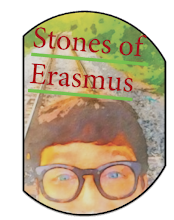Janus of the Villa Medici Tee – Roman Mythology Style
Step into the rich world of Roman art and mythology with this unisex staple tee, featuring an intricately engraved bust of Janus—god of beginnings, doorways, and time—as seen in the gardens of the Villa of the Medicis. Rendered in fine-point, monochrome detail, the dual-facing profile captures Janus’s power to look both backward and forward. On the back, a discreet “stonesoferasmus.com” reminds you of your journey through the stones of history.
Perfect for classicists, humanities teachers, museum lovers, and anyone drawn to the magic of ancient Rome, this shirt pairs effortlessly with jeans, jackets, or layered under a blazer for an academic-chic look.
Unwrapping and Wearing My Roman God T-Shirt
I just got out of the shower, but I had to show y’all this new package I just got—it’s gonna be exciting!
So, I found this public domain image in a 19th-century book that featured illustrations of Roman villas. Since it’s out of copyright, I took the original image and used Adobe Illustrator to turn it into a vector graphic. I cleaned it up, and this inscription—originally carved in stone—was found in the gardens of Cardinal de Medici, near the villa of Pope Julius III.
I used a font (I think it’s Laundrina Outline) to recreate the text. So, while the inscription isn’t from the original site, the rest of the design is based on historical artwork.
This is actually the first piece of merch from my Stones of Erasmus store (Link in Bio)! The design features a Roman god—if you know who it is, drop a comment. The shirt design is the same. Here’s the purchase info—well, this is the shirt I designed, and it’s available on my Stones of Erasmus website.
And check this out—this other shirt features Dionysus with a panther, which is one of his sacred animals. I found the image in the public domain and loved how expressive it felt. I hate those crinkly-feeling t-shirts—but this one? It’s so soft and smooth.
Oh, and I colored this one myself! The original illustration was in black and white, but I added the color. Fun fact: I also use these kinds of images in my educational resources, so it’s cool to see them on merch.
And yes—I can be a capitalist swine—check out stonesoferasmus.com 😄
I love how this stuff looks. It’s bold but not too loud.
Product Details
- 100% combed and ring-spun cotton (Heather colors contain polyester)
- Fabric weight: 4.2 oz/yd² (142 g/m²)
- Pre-shrunk fabric with side-seamed construction and shoulder-to-shoulder taping
- Sublimated print for long-lasting clarity and detail
- Unisex fit: flattering on all body types
- In White, Silver, Ice Blue, Citron, Ash
Carry a piece of Roman heritage wherever you go—because every new chapter begins at your doorstep.
PDF Copy for Printing



